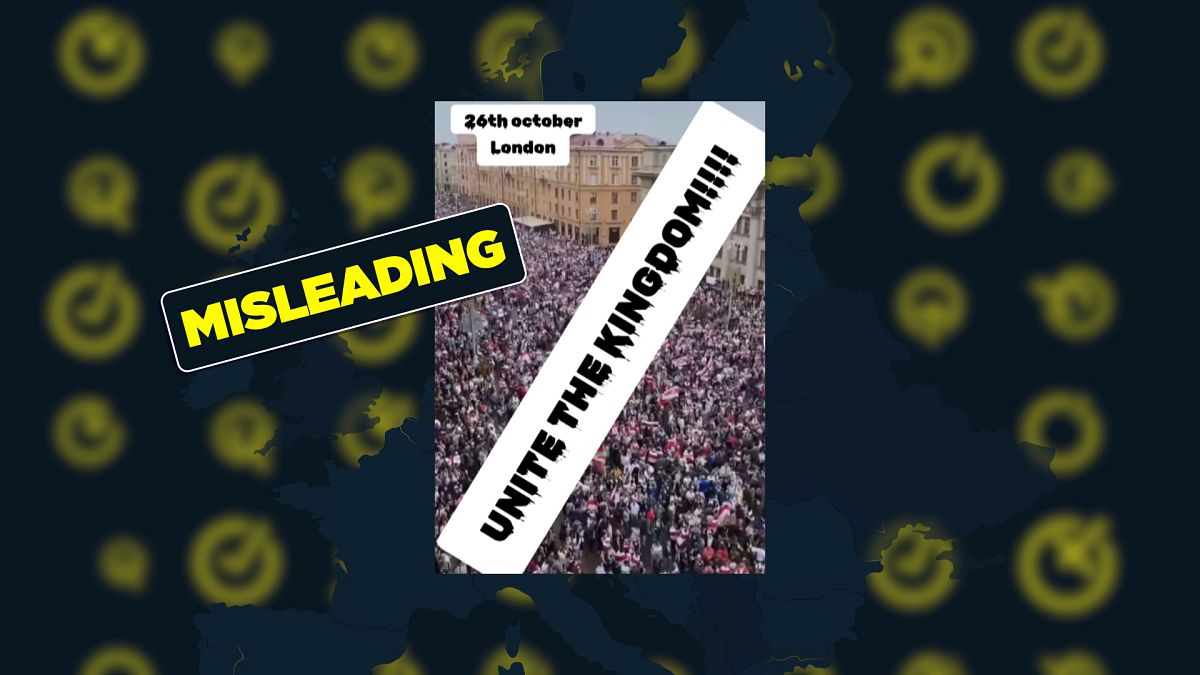A misleading video has been circulating on social media, claiming to show a far-right demonstration in London in October 2024. The video, which has been shared on platforms like TikTok and X, depicts a large crowd on a main street waving red and white flags with a text overlay reading “Unite the kingdom”. The video also falsely claims that 300,000 British nationalists gathered in London on the 26th of October, alongside references to far-right activist Tommy Robinson. However, upon closer inspection using reverse image search, it becomes clear that the footage actually shows an anti-government protest in the Belarusian capital of Minsk in August 2020.
The anti-government protests in Belarus erupted after President Alexander Lukashenko declared a landslide victory in the 2020 presidential election with 80% of the vote. His main challenger, Sviatlana Tsikhanouskaya, and her supporters contested the results, alleging electoral fraud and sparking mass demonstrations. More than 100,000 people took to the streets of Minsk on consecutive Sundays to demand Lukashenko’s resignation and the release of political prisoners. Despite attempts by the police to disperse the crowds with water cannons, the protesters remained resolute in their calls for change. Lukashenko dismissed the protests as orchestrated by foreign powers, denying any wrongdoing.
The viral video incorrectly attributed to a far-right London march actually captures the fervor of the Belarusian protests, as seen through the lens of Minsk’s Independence Street and Independence Square. The inclusion of Minsk’s Government House in the footage further solidifies its origins in the Belarusian capital. Contrary to the claims made in the video, there was no such gathering of British nationalists in London in October 2024. The video serves as a reminder of the power of misinformation on social media and the importance of fact-checking before sharing content.
In a time when disinformation runs rampant online, it is crucial for individuals to verify the accuracy of the content they come across before perpetuating falsehoods. The misrepresentation of events, such as the Belarusian protests, can have wide-reaching implications and shape public perception in unintended ways. By utilizing tools like reverse image search, individuals can uncover the true context of images and videos, preventing the spread of misinformation. It is essential to exercise discernment and critical thinking in the digital age to combat the proliferation of false narratives.
As we navigate the complexities of a connected world, it is incumbent upon all internet users to be vigilant against misinformation and disinformation campaigns. The case of the misleading video purportedly showing a far-right London demonstration highlights the need for media literacy and responsible sharing practices. By cultivating a habit of fact-checking and verifying sources, we can contribute to a more informed and truthful online ecosystem. Let us strive to uphold the integrity of information and resist the allure of sensationalized or misleading content that may undermine the trustworthiness of online platforms. Together, we can combat falsehoods and promote a climate of accuracy and transparency in the digital landscape.











